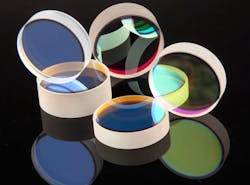At what depth is a multilayer reflective coating actually reflecting the incident light (shown are some dielectric mirrors from Laser Components)? Martin van Exter and Corné Koks of Leiden University (Leiden, Netherlands) have done some calculations to try to more precisely pin this down, as they say that some other recent studies have not correctly modeled the penetration depth and have used incorrect equations. “To tell you the truth, many researchers have been a bit sloppy,” says van Exter. “We have dotted some Is and crossed some Ts.” A multilayer coating serves as a distributed Bragg reflector (DBR), with layers of alternating low and high refractive indices; the two researchers not only did an analysis that involves three different penetration depths (and analyses of DBRs starting with either a low- or high-index layer, called L-DBRs and H-DBRs, respectively), but they also tested their analysis experimentally on microcavities. The conclusion is that there are three different penetration depths, depending on what exactly one would like to measure.
A standing wave of light within a cavity has nodes (where the amplitude is zero) and antinodes (where the amplitude is maximal). The point in the mirror where the node is located was dubbed the phase-penetration depth by van Exter and Koks. For light of one wavelength, the penetration depth is not very deep—typically almost on the surface of the mirror. But a pulse, especially an ultrafast pulse, has a range of frequencies. “When you calculate how fast this pulse returns, and therefore from what depth, the penetration depth turns out to be larger,” says van Exter. “This, we call the frequency-penetration depth.” In addition, the physicists define a third modal-penetration depth, applicable for sharply focused beams of light.
“These are not revolutionary changes,” says van Exter, “but we do show this for the first time, and we note that physicists are often sloppy when calculating their optical setups.” The differences are important for optical microcavities that are only a few microns deep, as the reflection depth helps determine the actual cavity length. Sample experimental measurements made by the researchers include a frequency-penetration depth of 0.28 μm and modal-penetration depth of 0.06 μm, which agreed with their theory. Reference: C. Koks and M. P. van Exter, Opt. Express (2021); https://doi.org/10.1364/oe.412346.

